热电阻式传感器587972
- 格式:pptx
- 大小:1.06 MB
- 文档页数:45
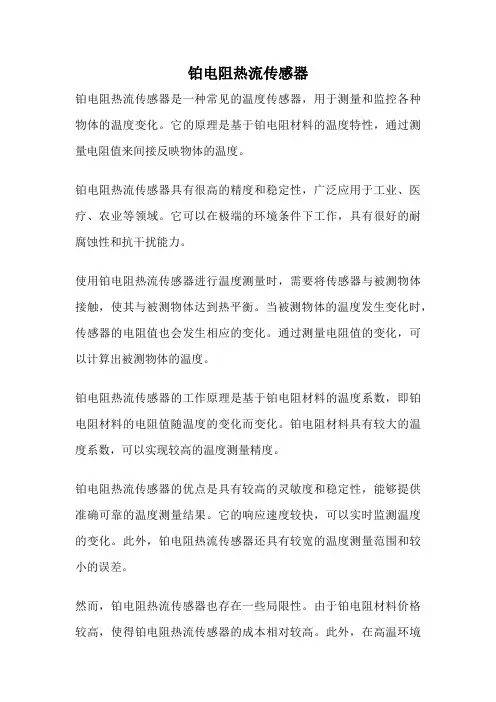
铂电阻热流传感器
铂电阻热流传感器是一种常见的温度传感器,用于测量和监控各种物体的温度变化。
它的原理是基于铂电阻材料的温度特性,通过测量电阻值来间接反映物体的温度。
铂电阻热流传感器具有很高的精度和稳定性,广泛应用于工业、医疗、农业等领域。
它可以在极端的环境条件下工作,具有很好的耐腐蚀性和抗干扰能力。
使用铂电阻热流传感器进行温度测量时,需要将传感器与被测物体接触,使其与被测物体达到热平衡。
当被测物体的温度发生变化时,传感器的电阻值也会发生相应的变化。
通过测量电阻值的变化,可以计算出被测物体的温度。
铂电阻热流传感器的工作原理是基于铂电阻材料的温度系数,即铂电阻材料的电阻值随温度的变化而变化。
铂电阻材料具有较大的温度系数,可以实现较高的温度测量精度。
铂电阻热流传感器的优点是具有较高的灵敏度和稳定性,能够提供准确可靠的温度测量结果。
它的响应速度较快,可以实时监测温度的变化。
此外,铂电阻热流传感器还具有较宽的温度测量范围和较小的误差。
然而,铂电阻热流传感器也存在一些局限性。
由于铂电阻材料价格较高,使得铂电阻热流传感器的成本相对较高。
此外,在高温环境
下,铂电阻材料可能会发生氧化或熔化,影响传感器的性能。
总的来说,铂电阻热流传感器是一种功能强大、精度高的温度传感器。
它在各个领域都有广泛的应用,为温度测量提供了可靠的解决方案。
随着科技的不断进步,铂电阻热流传感器的性能将进一步提升,为各行业的温度监测和控制提供更好的支持。


室内、室外、通道温度测量热电阻⏹测温范围-50~+90℃(200℃)⏹用于空调行业⏹防护等级从IP20到IP65⏹二线制、三线制或四线制连接⏹可提供变送器一体化型(4~20mA或0~10V)该电阻温度计主要应用于空调系统,用来测量室温、通风孔及室外的温度。
采用不同的塑料外壳以满足各种特殊应用所要求的不同防护等级。
传感器通常使用一支符合DIN EN 60751 B级二线制的Pt100热电阻,也可提供Pt500、Pt1000、Ni1000型和各种NTC版本。
从接线盒开始可进行三线或四线连接,可提供变送器一体化型。
技术数据接线盒塑料PC支架(材料PP对应型号902520/11),防护等级从IP20到IP65 型号902524/25防护等级IP54和IP65保护管不锈钢1.4571,直径6mm热电阻插芯Pt100热电阻温度传感器,DIN EN 60751 B级,二线制Pt1000热电阻温度传感器,DIN EN 60751 B级,二线制更多热电阻温度传感器请参考选型说明变送器模拟变送器,输出4~20mA或0~10V变送器1所指数据为量程满度20mA2使用较高数据认证/认证标准接线图标准版本变送器用于基本型号902520/10变送器适用于基本型号902520/2x和902524/3x供电单元接线示例,4~20mA和0~10V外形尺寸基本型号 902520/10基本型号 902520/11基本型号 902520/15基本型号 902520/21基本型号 902520/22基本型号902520/23基本型号 902520/24基本型号 902524/25基本型号 902524/31基本型号 902524/32选型说明:室内、室外、通道温度测量热电阻(1)基本型号(1)(2)(3)(4)(5)选型代码- - / (1)选型举例902520/10 - 572 - 1001 - 1 / 0001请逐一列出附加代码,代码顺序由小到大,用逗号隔开2请指明测量范围选型说明:室内、室外、通道温度测量热电阻(1)基本型号×658(1)(2)(3)(4)(5)选型代码- - /选型举例902520/21 - 573 - 1003 - 1 / 000选型说明:室内、室外、通道温度测量热电阻(1)基本型号(1)(2)(3)(4)(5)(6)(7)(8)选型代码- - - - - - / (1)选型举例902524/25 - 380 - 1003 - 1 - 6 - 100 - 000 / 0001请逐一列出附加代码,代码顺序由小到大,用逗号隔开2工艺连接可在“工艺连接附件”部分找到选型说明:室内、室外、通道温度测量热电阻(1)基本型号(1)(2)(3)(4)(5)(6)(7)(8)- - - - - / (1)902524/31 - 380 - 1003 - 1 - 6 - 100 - 000 / 0001请逐一列出附加代码,代码顺序由小到大,用逗号隔开2请指明测量范围过程连接附件。
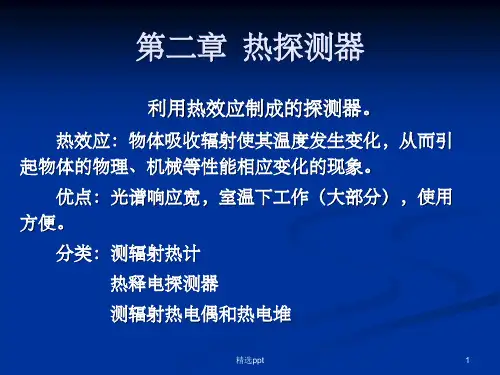
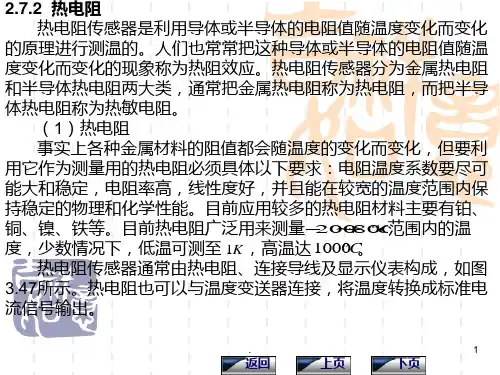
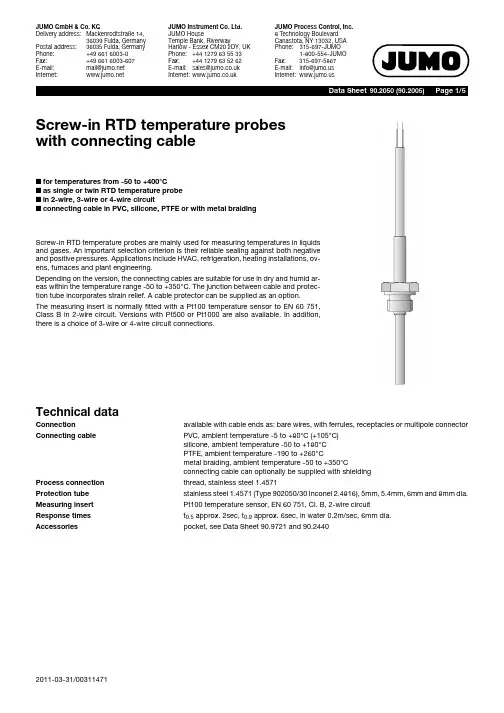
90.2050 (90.2005)Page 1/5Fax:+49 661 6003-607E-mail:Internet: Fax:+44 1279 63 52 62E-mail:Internet: Fax:315-697-5867E-mail:Internet:Screw-in RTD temperature probes with connectingcable■for temperatures from -50 to +400°C■as single or twin RTD temperature probe ■in 2-wire, 3-wire or 4-wire circuit■connecting cable in PVC, silicone, PTFE or with metal braidingScrew-in RTD temperature probes are mainly used for measuring temperatures in liquids and gases. An important selection criterion is their reliable sealing against both negative and positive pressures. Applications include HVAC, refrigeration, heating installations, ov-ens, furnaces and plant engineering.Depending on the version, the connecting cables are suitable for use in dry and humid ar-eas within the temperature range -50 to +350°C. The junction between cable and protec-tion tube incorporates strain relief. A cable protector can be supplied as an option.The measuring insert is normally fitted with a Pt100 temperature sensor to EN 60 751,Class B in 2-wire circuit. Versions with Pt500 or Pt1000 are also available. In addition,there is a choice of 3-wire or 4-wire circuit connections.Technical dataConnection available with cable ends as: bare wires, with ferrules, receptacles or multipole connector Connecting cablePVC, ambient temperature -5 to +80°C (+105°C)silicone, ambient temperature -50 to +180°C PTFE, ambient temperature -190 to +260°Cmetal braiding, ambient temperature -50 to +350°Cconnecting cable can optionally be supplied with shielding Process connection thread, stainless steel 1.4571Protection tube stainless steel 1.4571 (Type 902050/30 Inconel 2.4816), 5mm, 5.4mm, 6mm and 8mm dia.Measuring insert Pt100 temperature sensor, EN 60 751, Cl. B, 2-wire circuit Response times t 0.5 approx. 2sec, t 0.9 approx. 6sec, in water 0.2m/sec, 6mm dia.Accessoriespocket, see Data Sheet 90.9721 and 90.244090.2050 (90.2005)Page 2/5Fax:+49 661 6003-607E-mail:*************Internet: Fax:+44 1279 63 52 62E-mail:*************.uk Internet: Fax:315-697-5867E-mail:************Internet:DimensionsType 902050/10Type 902050/20Type 902050/30Type 902050/4090.2050 (90.2005)Page 3/5Fax:+49 661 6003-607E-mail:*************Internet: Fax:+44 1279 63 52 62E-mail:*************.uk Internet: Fax:315-697-5867E-mail:************Internet:Order details:Screw-in RTD temperature probes with connecting cable(1)Basic version902050/10Screw-in RTD temperature probe with fixed screw fitting902050/20Screw-in RTD temperature probe with loose screw fitting(2)Operating temperature in °C / connecting cablex x 130-200 to +400°C / metal braiding x x 380-50 to +200°C / silicone x x 386-50 to +260°C / PTFEx x 402-50 to +400°C / metal braiding x x 724-5 to +80°C / PVCx x 912 5 to 105°C / PVC (only with 1 x 2-wire or 3-wire circuit)(3)Measuring insertx x 1001 1 x Pt100 in 3-wire circuit x x 1003 1 x Pt100 in 2-wire circuit x x 1011 1 x Pt100 in 4-wire circuit x x 2001 2 x Pt100 in 3-wire circuit xx20032 x Pt100 in 2-wire circuit (4)Tolerance class to EN 60 751x x 1Class B (standard)x x 2Class A (5)Protection tube diameter D in mm x x 55mm x x 66mm (6)Fitting length EL in mm (50≤ EL ≤500)x 1717mm x 3737mm x x 5050mm x x 100100mm x 137137mm x x 200200mm x 250250mmx x ...please specify in plain text (50mm steps)(7)Process connectionx 102thread 1/4"pipe x 104thread 1/2"pipe x 114thread M 10 x 1(8)Connecting cable endx x 03bare cable endsx x 11ferrules to DIN 46 228 Part 4 (standard)x x 13receptacle 6.3 to DIN 46 247x x 80multipole connector (please specify type in plain text)x x99to customer specification (9)Connecting cable length AL in mm (500≤ AL ≤500000)x x 25002500mmx x ...please specify in plain text (500mm steps)(10)Extra codesx x 000no extra codex x 310stepped protection tube x x 315cable protector: coil x x 316cable protector: tubex x317shielded connecting cable(1)(2)(3)(4)(5)(6)(7)(8)(9)(10)Order code --------/ ,...Order example902050/10-380-1001-1-6-100-104-11-2500/00011.List extra codes in sequence, separated by commas.90.2050 (90.2005)Page 4/5Fax:+49 661 6003-607E-mail:*************Internet: Fax:+44 1279 63 52 62E-mail:*************.uk Internet: Fax:315-697-5867E-mail:************Internet:Order details:Screw-in RTD temperature probes with connecting cable(1)Basic version902050/30Screw-in RTD temperature probe with loose screw fitting and stepped protection tube(2)Operating temperature in °C / connecting cablex 380-50 to +200°C / silicone (3)Measuring insertx 1001 1 x Pt100 in 3-wire circuit x 10031 x Pt100 in 2-wire circuit(4)Tolerance class to EN 60 751x 1Class B (standard)x 2Class A (5)Protection tube diameter D in mm x 5.4 5.4mm dia. stepped down to 3.3mm (6)Fitting length EL in mm x 27.527.5mm (7)Process connection x 114thread M 10 x 1(8)Connecting cable endx 03bare cable endsx 11ferrules to DIN 46 228 Part 4 (standard)x 13receptacle 6.3 to DIN 46 247x 80multipole connector (please specify type in plain text)x 99to customer specification(9)Connecting cable length AL in mm (500≤ AL ≤500000)x 25002500mm x ...please specify in plain text (500mm steps)(10)Extra codesx 000no extra codex 315cable protector: coil x 316cable protector: tubex317shielded connecting cable(1)(2)(3)(4)(5)(6)(7)(8)(9)(10)Order code--------/ ,...Order example902050/30-380-1003-1-5.4-27.5-114-11-2500/00011.List extra codes in sequence, separated by commas.90.2050 (90.2005)Page 5/5Fax:+49 661 6003-607E-mail:*************Internet: Fax:+44 1279 63 52 62E-mail:*************.uk Internet: Fax:315-697-5867E-mail:************Internet:Order details:Screw-in RTD temperature probes with connecting cable(1)Basic version902050/40Screw-in RTD temperature probe, screw-in protection tube(2)Operating temperature in °C / connecting cablex 380-50 to +200°C / siliconex 390-50 to +300°C / metal braiding x 724-5 to +80°C / PVCx 9125 to 105°C / PVC (only with 1 x 2-wire or 3-wire circuit)(3)Measuring insertx 1001 1 x Pt100 in 3-wire circuit x 1003 1 x Pt100 in 2-wire circuit(4)Tolerance class to EN 60 751x 1Class B (standard)x 2Class A(5)Protection tube diameter D in mmx 8M 8(6)Fitting length EL in mmx 2525mm (7)Process connectionx 111thread M 8(8)Connecting cable endx 03bare cable endsx 11ferrules to DIN 46 228 Part 4 (standard)x 13receptacle 6.3 to DIN 46 247x 80multipole connector (please specify type in plain text)x 99to customer specification (9)Connecting cable length AL in mm (500≤ AL ≤500000)x 25002500mmx ...please specify in plain text (500mm steps)(10)Extra codesx 000no extra codex 315cable protector: coil x 316cable protector: tubex317shielded connecting cable(1)(2)(3)(4)(5)(6)(7)(8)(9)(10)Order code--------/ ,...Order example902050/40-390-1003-1-8-25-111-11-2500/00011.List extra codes in sequence, separated by commas.Stock versions:(1)(2)(3)(4)(5)(6)(7)(8)(9)(10)Sales No.--------/902050/10-380-1001-1-6-100-104-11-2500/31690/00065232902050/10-380-1001-1-6-250-104-11-2500/31690/00065235902050/20-130-1003-1-6-37-114-11-2500/315,31790/00055644902050/20-130-1001-1-6-37-114-11-2500/315,31790/00055646902050/30-380-1001-1- 5.4-27.5-114-11-2500/31690/00089972902050/40-390-1003-1-8-25-111-11-2500/315,31790/00055722902050/40-390-1001-1-8-25-111-11-2500/315,31790/00055732。
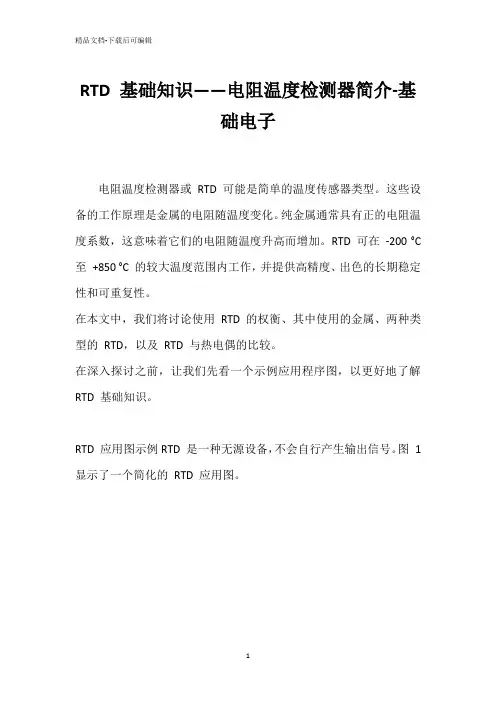
RTD 基础知识——电阻温度检测器简介-基础电子电阻温度检测器或RTD 可能是简单的温度传感器类型。
这些设备的工作原理是金属的电阻随温度变化。
纯金属通常具有正的电阻温度系数,这意味着它们的电阻随温度升高而增加。
RTD 可在-200 °C 至+850 °C 的较大温度范围内工作,并提供高精度、出色的长期稳定性和可重复性。
在本文中,我们将讨论使用RTD 的权衡、其中使用的金属、两种类型的RTD,以及RTD 与热电偶的比较。
在深入探讨之前,让我们先看一个示例应用程序图,以更好地了解RTD 基础知识。
RTD 应用图示例RTD 是一种无源设备,不会自行产生输出信号。
图1 显示了一个简化的RTD 应用图。
图1.RTD 应用图示例。
图片由TI提供激励电流I1 通过传感器的温度相关电阻。
这会产生一个与激励电流和RTD 电阻成正比的电压信号。
RTD 两端的电压然后被放大并传送到ADC(模数转换器)以产生可用于计算RTD 温度的数字输出代码。
使用RTD 传感器的权衡——RTD 传感器的优点和缺点在深入研究之前,请务必注意RTD 信号调理的详细信息将在以后的文章中介绍。
对于本文,我想强调使用RTD 电路时的一些基本权衡。
首先,请注意,激励电流通常限制在 1 mA 左右,以限度地减少自热效应。
当激励电流流过RTD 时,它会产生I2R 或焦耳热。
自热效应可以将传感器温度升高到高于实际测量的周围环境温度的值。
减小励磁电流可以降低自热效应。
还值得一提的是,自热效应取决于RTD 浸入的介质。
例如,放置在静止空气中的RTD 的自热效应可能比浸入流动水中的RTD 更明显。
对于给定的可检测温度变化,RTD 电压的变化应该足够大以克服系统噪声以及不同系统参数的偏移和漂移。
由于自热效应限制了激励电流,我们需要使用电阻足够大的RTD,因此会为下游信号处理块产生较大的电压。
虽然需要较大的RTD 电阻以减少测量误差,但我们不能任意增加电阻,因为较大的RTD 电阻会导致响应时间变慢。

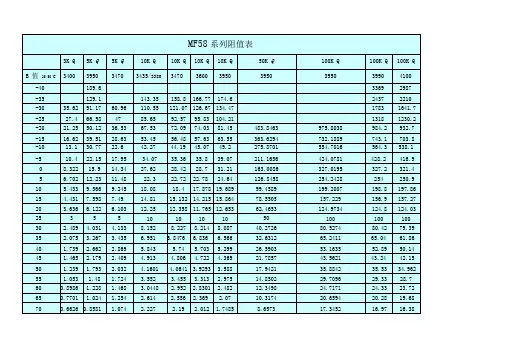
B值是热敏电阻器的材料常数,即热敏电阻器的芯片(一种半导体陶瓷)在经过高温烧结后,形成具有一定电阻率的材料,每种配方和烧结温度下只有一个B值,所以种之为材料常数。
B值可以通过测量在25摄氏度和50摄氏度(或85摄氏度)时的电阻值后进行计算。
B值与产品电阻温度系数正相关,也就是说B值越大, 其电阻温度系数也就越大。
温度系数就是指温度每升高1度,电阻值的变化率。
采用以下公式可以将B值换算成电阻温度系数:
电阻温度系数=B值口八2 (T为要换算的点绝对温度值)
NTC热敏电阻器的B值一般在2000K -6000K之间,不能简单地说B值是越大越好还是越小越好,要看你用在什么地方。
一般来说,作为温
度测量、温度补偿以及抑制浪涌电阻用的产品,同样条件下是B值大点好。
因为随着温度的变化,B值大的产品其电阻值变化更大,也就是说更灵敏。
以上就是按我自己的理解所做的回答,我是做这个的,如果你还有什么问题,可以加我为好友,或给我发送信息。
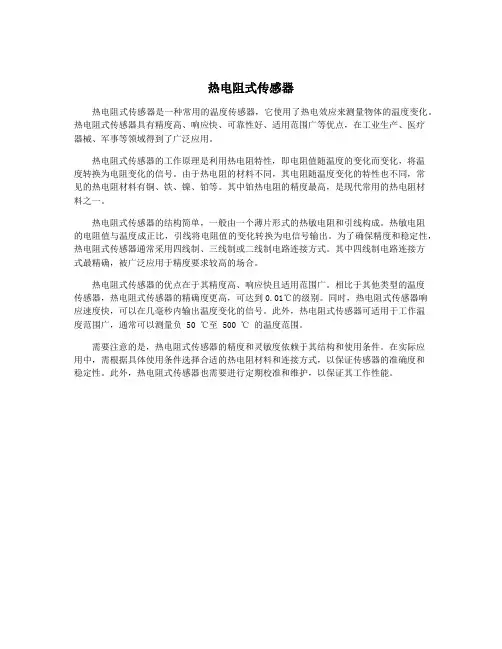
热电阻式传感器
热电阻式传感器是一种常用的温度传感器,它使用了热电效应来测量物体的温度变化。
热电阻式传感器具有精度高、响应快、可靠性好、适用范围广等优点,在工业生产、医疗
器械、军事等领域得到了广泛应用。
热电阻式传感器的工作原理是利用热电阻特性,即电阻值随温度的变化而变化,将温
度转换为电阻变化的信号。
由于热电阻的材料不同,其电阻随温度变化的特性也不同,常
见的热电阻材料有铜、铁、镍、铂等。
其中铂热电阻的精度最高,是现代常用的热电阻材
料之一。
热电阻式传感器的结构简单,一般由一个薄片形式的热敏电阻和引线构成。
热敏电阻
的电阻值与温度成正比,引线将电阻值的变化转换为电信号输出。
为了确保精度和稳定性,热电阻式传感器通常采用四线制、三线制或二线制电路连接方式。
其中四线制电路连接方
式最精确,被广泛应用于精度要求较高的场合。
热电阻式传感器的优点在于其精度高、响应快且适用范围广。
相比于其他类型的温度
传感器,热电阻式传感器的精确度更高,可达到0.01℃的级别。
同时,热电阻式传感器响应速度快,可以在几毫秒内输出温度变化的信号。
此外,热电阻式传感器可适用于工作温
度范围广,通常可以测量负50 ℃至500 ℃ 的温度范围。
需要注意的是,热电阻式传感器的精度和灵敏度依赖于其结构和使用条件。
在实际应
用中,需根据具体使用条件选择合适的热电阻材料和连接方式,以保证传感器的准确度和
稳定性。
此外,热电阻式传感器也需要进行定期校准和维护,以保证其工作性能。